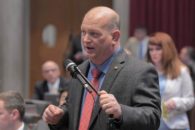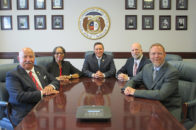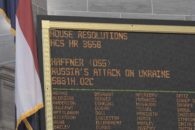By the Missouri Highways and Transportation Commission
In a short four months the next session of the Missouri General Assembly will begin. And following November’s election, there are certain to be a lot of new faces at the Capitol.
At our September meeting, the Missouri Highways and Transportation Commission established legislative priorities for 2017, focusing on three categories: safety, innovation and federal mandate.
Safety
Last year, 870 people died in highway crashes in Missouri – a 14 percent increase from 2014 – and 63 percent of those fatalities were not wearing a safety belt. Statistics also show that 20 percent of crashes involve some form of distracted driving, which could be texting, talking on the phone, eating, changing the radio, etc.
Two simple actions that wouldn’t cost a dime could save lives on Missouri’s highways, and they are two of our highest priorities.
Primary Enforcement of Safety Belt Law – The proposed legislation will allow a law enforcement officer to stop a driver solely for failure to wear their seat belt if the violation is clearly visible to the officer. Under the current “secondary” law, an officer must have stopped a driver for some other violation in order to also cite the driver for not wearing their safety belt. A primary seat belt law in Missouri would save 43 lives each year.
Prohibit the Use of Hand-Held Electronic Communication Devices While Driving – Missouri’s current law, passed in 2009, prohibits drivers 21 years of age and under from using hand-held electronic communication devices for text and other electronic messaging while driving. The proposed legislation would extend that prohibition to all drivers.
Use of Lighting on MoDOT Vehicles – In 2016, the General Assembly passed and Gov. Nixon signed into law SB 732 which included a provision that would limit the use of lights on MoDOT vehicles and equipment. The change in statute only allows fixed, flashing or rotating amber or white lights to be used on MoDOT vehicles that are stationary in a work zone and when highway workers are present.
This change in law is problematic for MoDOT employees who display these light configurations when performing a “moving” operation to enhance their visibility to the traveling public such as mowing along highway rights-of-way or plowing snow.
MoDOT staff would seek legislative relief by passing a bill to clean-up this unintended consequence as quickly as possible when session begins in January 2017.
Innovation
Commercial Motor Vehicle Platooning Pilot – Legislation would authorize a pilot project involving platooning of commercial motor vehicles. Platooning is a wireless connectivity between trucks that allows the second truck to follow at a close distance for better fuel economy and safety. Current state laws relating to commercial motor vehicles would remain intact. This proposal was passed by the General Assembly in 2016 as part of a larger omnibus transportation proposal. However, the bill was later vetoed by Gov. Nixon.
Federal Mandate
Increased Weights for Certain Vehicles – As a result of the passage of the 2015 federal Fixing America’s Surface Transportation Act (FAST Act), some changes to Missouri’s motor carrier laws are needed to be in agreement. Not adopting these federal provisions could result in a withholding of seven percent (or approximately $62 million) of federal highway funds for not having an adequate certification as determined by the U.S. Secretary of Transportation.
Two changes, specifically, need to be addressed: increasing the allowable length of an automobile transporter from 75 to 80 feet and towaway trailer transporters to 82 feet; and increasing the interstate weight of tractor-trailer formations to 82,000 lbs. from 80,000 lbs. for vehicles operated by an engine fueled primarily with natural gas.
And, of course, the Commission will watch with interest any funding bills that come forward to increase Missouri’s level of investment in its transportation system.







